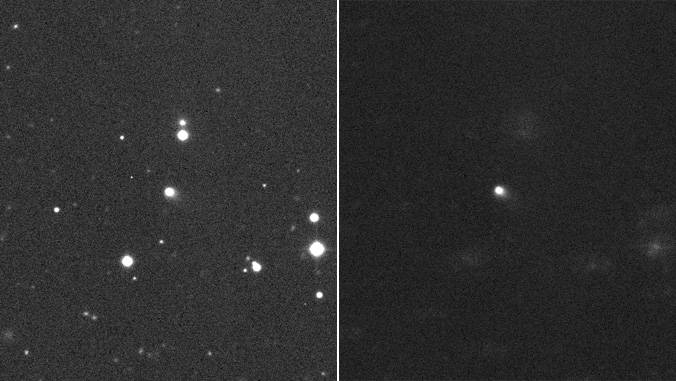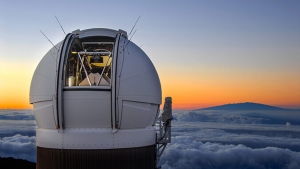
Right: Image of comet as it moves across the sky, a faint tail can be seen extending to the southwest (images: Canada-France-Hawaiʻi Telsecope)
A new comet discovered this summer by University of Hawaiʻi’s Pan-STARRS1 telescope atop Hakeakalā may become bright enough for spectators to see as it moves closer to Earth. UH Institute for Astronomy (IfA) astronomer Robert Weryk first spotted the comet on July 26, and after it was reported to the Minor Planet Center, telescopes from around the globe confirmed its cometary nature.
The discovery was officially announced August 1, and is named comet C/2021 O3 (PANSTARRS). At last check, the non-threatening object is about four times as far from the Earth as the Sun. It will become brighter and could be visible to the naked eye in late April or early May 2022.

“We are thrilled that Pan-STARRS has discovered a new comet that many people on Earth may be able to see,” said IfA Astronomer Richard Wainscoat, who leads the Near-Earth Object (NEO) survey project with Pan-STARRS. “Although it may be a little challenging to see with the unaided eye, it should be easy to see with binoculars or a small telescope.”
As Comet C/2021 O3 (PANSTARRS) approaches the Earth and the Sun next spring, the Sun’s radiation will warm the surface of the comet which will cause it to brighten as gas and dust are released from its icy surface. According to Wainscoat, the comet will be closest to the Sun on April 20, 2022, and will pass inside Mercury’s orbit.
Monitoring movement on Maunakea
UH astronomers will use telescopes on Maunakea to study the comet as it approaches and after it has passed the Sun. Some comets do not survive such close passages to the Sun. The best chance to see the comet may be in the first few days of May (before the Moon becomes too bright), when the comet will be low in the western sky after sunset. It may be easier to see from the neighbor islands than from Oʻahu, where there is more light pollution.
- Related UH News story: UH astronomers play key role in planetary defense, June 8, 2021
Pan-STARRS searches the sky every night for moving objects in an effort to discover NEOs such as asteroids and comets that may pose a threat. The 1.8-meter telescope is a world leader in finding larger NEOs, and is funded by NASA’s Planetary Defense Coordination Office through its Near-Earth Object Observations Program.
This research is an example of UH Mānoa’s goal of Excellence in Research: Advancing the Research and Creative Work Enterprise (PDF), one of four goals identified in the 2015–25 Strategic Plan (PDF), updated in December 2020.

